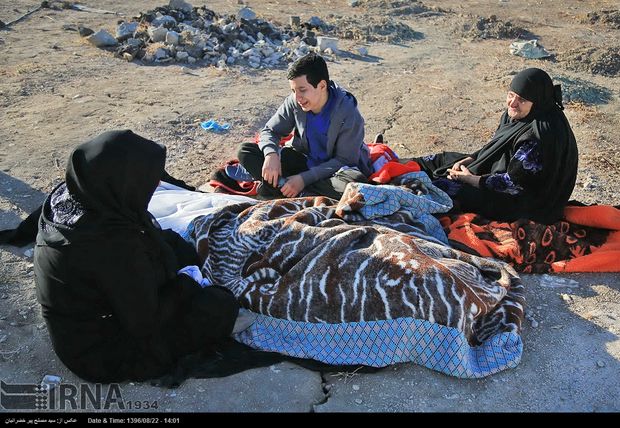CHRI – A reporter in Iran’s Kurdistan Province, hit by a 7.3 magnitude earthquake on November 12, 2017, told the Center for Human Rights in Iran (CHRI) that aid had not reached some of the most devastated villages and towns almost a full day after the earthquake had hit.
 “The Kouyek villages were completely leveled and no one had gone there to help 20 hours after the quake,” said the reporter, who requested anonymity for security reasons, on November 13. “When we got out of the car, people ran toward us thinking we were doctors. They wanted medicine, food, powdered milk, and water.”
“The Kouyek villages were completely leveled and no one had gone there to help 20 hours after the quake,” said the reporter, who requested anonymity for security reasons, on November 13. “When we got out of the car, people ran toward us thinking we were doctors. They wanted medicine, food, powdered milk, and water.”
“Their relatives were still under the rubble and no one was there to help them. Many had broken limbs,” said the reporter, who was dispatched to the province in Western Iran by a state news organization based in Tehran. “They were all crying. They had no blankets, no food, and no heaters in that cold weather. It was getting dark and we had to go back to Sarpol-e Zahab. We had to leave without being able to help them.”
State officials have so far reported that at least 452 people have died and more than 7,000 are injured. The epicenter of the earthquake was recorded near Ezgeleh, Iran, about 135 miles northeast of Baghdad in Iraq.
The reporter described a harrowing scene in a town where people had been living in government housing.
“The housing complex built by the state Mehr organization in Sarpol-e Zahab [city] was leveled,” the reporter told CHRI. “Bodies were being pulled out of the rubble hours after the earthquake happened.”
“I thought this was the extent of the disaster,” he added. “There were many aid workers and officials. The people told us to go to the villages near Sarpol-e Zahab in the Sardasht region and that’s when we realized the real extent of the disaster.”
The Mehr housing project was implemented under President Mahmoud Ahmadinejad’s administration (2005-13) to provide inexpensive housing to low-income families.
“The tents provided by the Red Crescent are not enough,” said the region’s parliamentary representative, Heshmatollah Falahatpisheh, according to the Iranian Labor News Agency (ILNA). “The temperature tonight will drop below freezing and many people will be left outside their homes.”
Falahatpisheh criticized what he described as the use of “poor quality material” and “lack of expertise” in the construction of the housing complex by the Mehr project and the hospital in Sarpol-e Zahab, which caused greater death and destruction than necessary.
Asked by CHRI why no help had been sent to the villages, the reporter replied: “I don’t know why no aid had been sent there. We heard a few aid workers in Sarpol-e Zahab saying that those in the villages were already dead and nothing could be done for them. In other words, they already assumed it was too late to help them. The villages were not very far from Sarpol-e Zahab. One of the officials said they would send them help tomorrow, but tomorrow is much too late.”
The only hospital in Sarpol-e Zahab, which was only recently constructed, was also destroyed. Injured people had to be taken to the nearest medical center in Qasr-e Shirin.
ILNA reported that heating equipment distributed by state officials in Sarpol-e Zahab was insufficient and the severe cold could endanger the lives of children and the elderly.
“Even in Sarpol-e Zahab, there were not enough tents and goods for the affected people,” said the reporter. “But there were lots of aid workers and officials. Perhaps they got there after seeing images posted online showing the destruction of the Mehr housing complex soon after the quake and they forgot about the villages. The Iranian Red Crescent Society workers and the army soldiers were helpful. But the villages would not be seeing any help until the next day.”
The reporter told CHRI: “We are hoping that after [President Hassan] Rouhani’s visit to the area tomorrow, the aid work will become more organized and faster.”
The region had experienced more than 100 aftershocks within the 24 hours after the earthquake had hit. Water and electricity are currently inaccessible in many areas of the province. The cities of Qasr-e Shirin, Azgeleh, Sarpol-e Zahab and Dalahou—all in Kermanshah—were the most severely impacted.
“It was so cold that we had to go inside our car to get warm, but fuel is low and running out. If we don’t get a tent or fuel soon we could freeze here,” a resident of Sarpol-e Zahab, identified as Mr. Nasser, told ILNA.
“There’s no food,” he added. “We got some cheese and bread from the stores that had not been destroyed and gave most of it to the kids.”
“The movement of different layers under the earth has muddied the water supply in the city and so we can’t provide water until the mud settles,” said the governor of Qasr-e Shirin, Faramarz Akbari.
Akbari said that in addition to medicine, water and food, the city needs 6,000 blankets and tents for emergency settlements for the people of two nearby towns and 25 villages devastated by the earthquake.
 Shabtabnews In this dark night, I have lost my way – Arise from a corner, oh you the star of guidance.
Shabtabnews In this dark night, I have lost my way – Arise from a corner, oh you the star of guidance.


